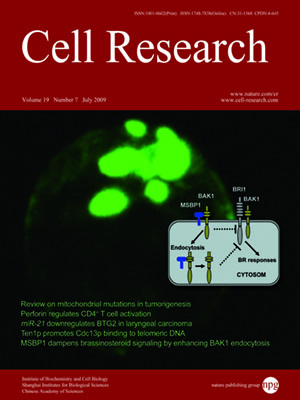
Volume 19, No 7, Jul 2009
ISSN: 1001-0602
EISSN: 1748-7838 2018
impact factor 17.848*
(Clarivate Analytics, 2019)
Volume 19 Issue 7, July 2009: 864-876
ORIGINAL ARTICLES
Membrane steroid-binding protein 1 (MSBP1) negatively regulates brassinosteroid signaling by enhancing the endocytosis of BAK1
Li Song1, Qiu-Ming Shi1, Xiao-Hua Yang1,2, Zhi-Hong Xu1 and Hong-Wei Xue1
1National Key Laboratory of Plant Molecular Genetics, Institute of Plant Physiology and Ecology, Shanghai Institutes for Biological Sciences, Chinese Academy of Sciences, 300 Fenglin Road, Shanghai 200032, China
2University of Maryland Biotechnology Institute, 9600 Gudelsky Drive, Rockville, MD 20850, USA
Correspondence: Hong-Wei Xue,(hwxue@sibs.ac.cn)
Brassinosteroids (BRs) are perceived by transmembrane receptors and play vital roles in plant growth and development, as well as cell in responses to environmental stimuli. The transmembrane receptor BRI1 can directly bind to brassinolide (BL), and BAK1 interacts with BRI1 to enhance the BRI1-mediated BR signaling. Our previous studies indicated that a membrane steroid-binding protein 1 (MSBP1) could bind to BL in vitro and is negatively involved in BR signaling. To further elucidate the underlying mechanism, we here show that MSBP1 specifically interacts with the extracellular domain of BAK1 in vivo in a BL-independent manner. Suppressed cell expansion and BR responses by increased expression of MSBP1 can be recovered by overexpressing BAK1 or its intracellular kinase domain, suggesting that MSBP1 may suppress BR signaling through interacting with BAK1. Subcellular localization studies revealed that both MSBP1 and BAK1 are localized to plasma membrane and endocytic vesicles and MSBP1 accelerates BAK1 endocytosis, which results in suppressed BR signaling by shifting the equilibrium of BAK1 toward endosomes. Indeed, enhanced MSBP1 expression reduces the interaction between BRI1 and BAK1 in vivo, demonstrating that MSBP1 acts as a negative factor at an early step of the BR signaling pathway.
Cell Research (2009) 19:864-876. doi: 10.1038/cr.2009.66; published online 16 June 2009
FULL TEXT | PDF
Browse 1904


